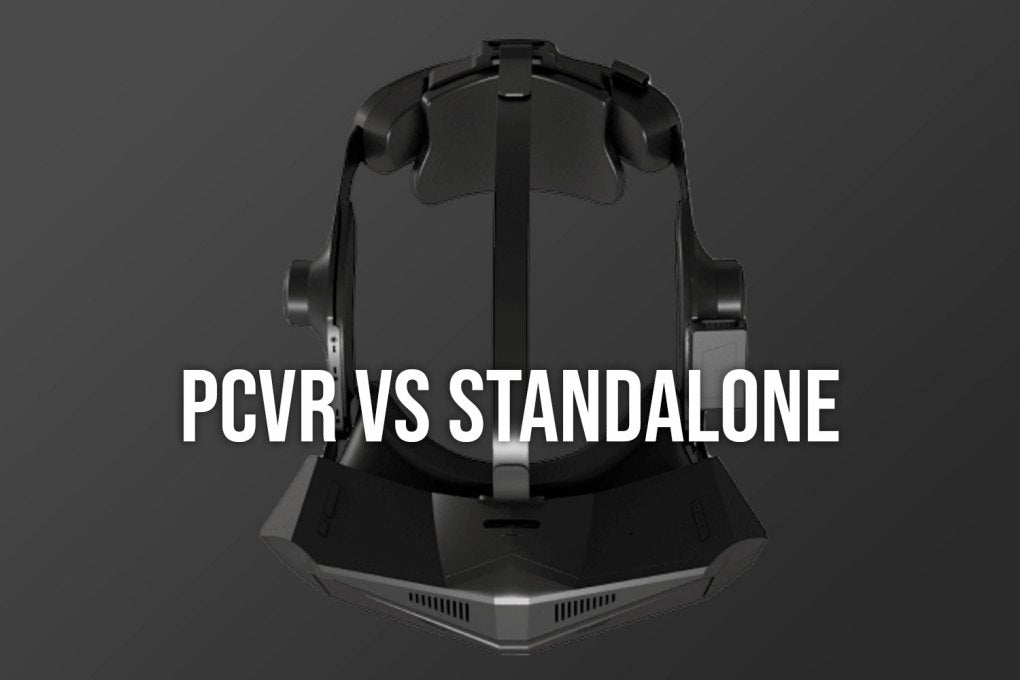Virtual Reality (VR) is a technology that completely immerses the user in a virtual environment. There are two main types of VR headsets: PCVR and Standalone VR. But what is the difference between these two types of VR? Which one is best for you? Let's take a look.
PCVR
PCVR, or PC Virtual Reality, uses a powerful computer to make the VR experience possible. So basically your VR headset is a monitor you put on your head, but it doesn't do any of the rendering of the game.
Advantages of PCVR:
The VR headset is connected to a PC (hence the name), and uses the GPU of the computer to render the images. This makes the VR experience smooth, even at extremely high resolutions (the Pimax Crystal for example, has a resolution of 5760 x 2880 pixels). This means that the graphics quality of PCVR can be significantly higher than Standalone VR, because a good desktop gaming PC is much more powerful than the processor and GPU in a standalone VR headset.
Another advantage of PCVR is the ability to take advantage of the best VR games and applications on the market. Many of these games and applications are designed for use with PCVR headsets and cannot be played on a standalone headset. Games like Microsoft Flight Simulator or racing sims like iRacing are extremely GPU-intensive and therefore you can only have such an experience with PCVR.

Disadvantages of PCVR:
In general, PCVR headsets and having a gaming PC is more expensive than a standalone VR headset. It is also slightly harder to set it up, as you need to install software such as SteamVR or OpenXR, although everyone can do this (and if not, there are communities to help you out).
In short, PCVR:
Advantages:
- The widest VR possibilities at the highest graphic performance
- More customization options and top games such as flight & racing sims
- Not limited to any brand’s VR app ecosystem, so more games are available
Disadvantages:
- Requires a powerful gaming PC
- Requires you to set it up
- Generally more expensive VR headsets
Standalone VR
Standalone VR headsets, such as the popular Oculus Quest 2, use a built-in processor to power the VR experience. This means that no computer is required to use the headset. Standalone VR headsets are usually less powerful than PCVR headsets, but still provide an impressive VR experience.
Why Standalone VR:
One of the biggest advantages of Standalone VR is its portability. You can take the headset with you wherever you go and enjoy the VR experience on the go. In addition, installation is much easier than with PCVR, as no computer is required.
Downsides of standalone VR:
The downside of Standalone VR is that the graphics quality is usually not as high as PCVR. Nor do you have many customization options. In addition, the range of games is more limited than with PCVR, because not all games and applications can be played on standalone headsets.

In short, standalone:
Advantages:
- Easy to set-up
- Don’t need an expensive gaming PC, in fact you don’t need a PC at all!
- More affordable as a result
- No cables so more freedom to move
Disadvantages:
- Limited to the headset’s ecosystem
- Less stellar graphic performance compared to PCVR
Both in one headset
The Pimax Crystal (and the upcoming 12K) have both standalone and PCVR modes. You do have to switch between the modes on the device, but you can both play SteamVR or OpenXR in the PCVR mode and Standalone VR games in the standalone mode, totally without any PC connected.
Standalone mode usually has also the benefit of not needing any cables, but with the 60G Airlink module for the Pimax Crystal, you can enjoy PCVR without cables as well. Demo:
Here's a demo of the Standalone mode:
And PCVR:
Conclusion: PCVR vs Standalone VR
In short, the difference between PCVR and Standalone VR mainly lies in the power and portability of the headset and the graphics quality. PCVR offers the highest quality graphics and the best VR games and applications, but requires a powerful computer and is less portable. Standalone VR, on the other hand, is portable and easier to set up, but the graphics quality is usually lower and the range of games and applications is more limited. The choice between the two depends on personal preference and intended use. Yet with the Pimax Crystal, you can have both.
Blade & Sorcery

Onward

MSFS2020









